Community Development: An Essay on the Yiriman Project's Impact
VerifiedAdded on 2022/09/28
|12
|3114
|25
Essay
AI Summary
This essay provides a comprehensive analysis of the Yiriman Project, a community development initiative focused on Aboriginal youth in Western Australia. It delves into the project's historical context, tracing its origins to address issues like drug abuse and cultural erosion among young community members. The essay examines the creative processes employed, such as bush trips and cultural reconnection activities, highlighting the involvement of elders, youth, and service providers. It assesses the strengths of these processes, including their participatory nature and emphasis on cultural values, while also acknowledging weaknesses like funding limitations and the challenges of quantitative impact assessment. Furthermore, the essay explores lessons learned, such as the role of culture in strengthening morals and the cost-effectiveness of the project, and suggests improvements for enhancing its effectiveness, such as incorporating quantitative monitoring and expanding community involvement. The analysis is based on extensive research and draws upon the provided case study and related literature.
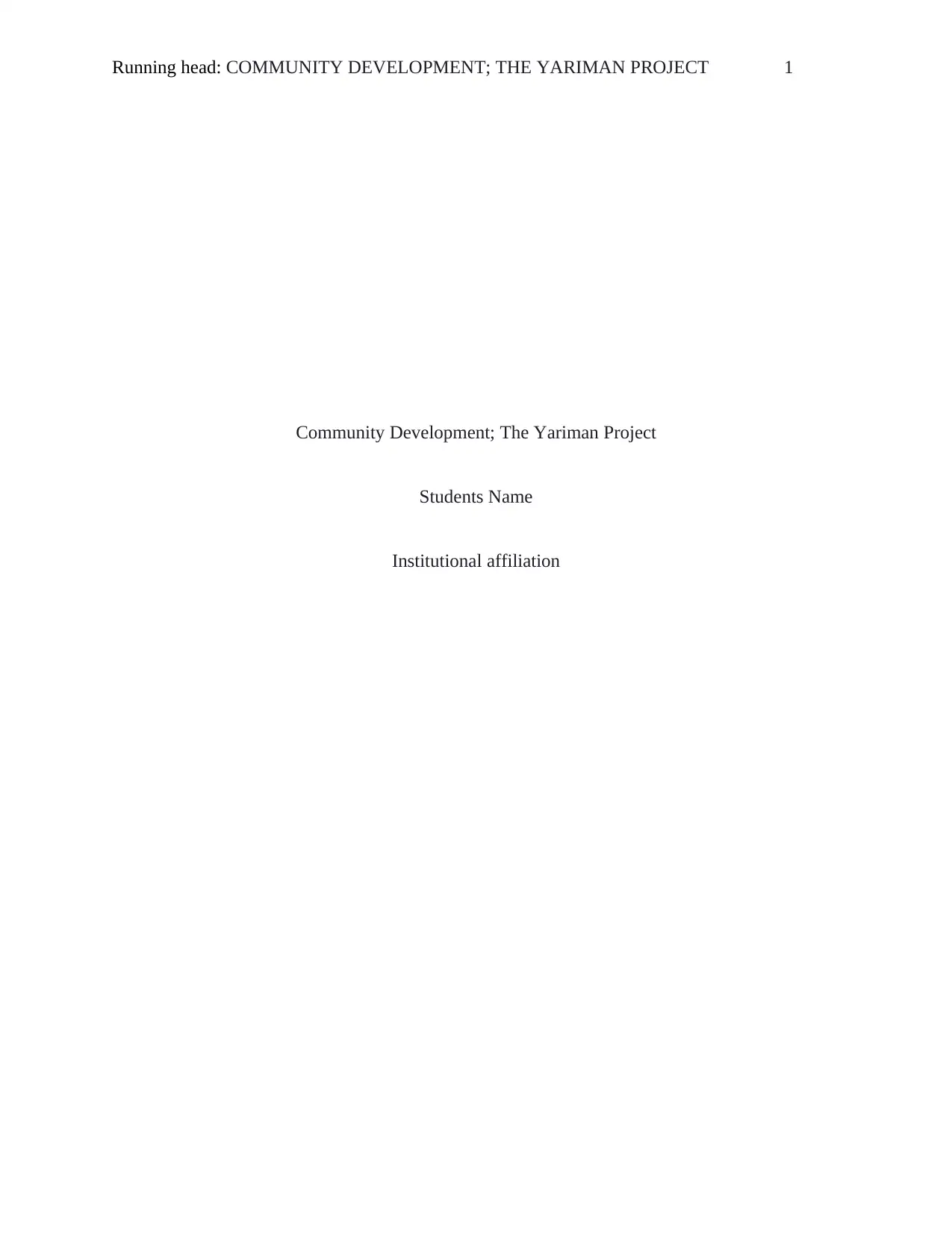
Running head: COMMUNITY DEVELOPMENT; THE YARIMAN PROJECT 1
Community Development; The Yariman Project
Students Name
Institutional affiliation
Community Development; The Yariman Project
Students Name
Institutional affiliation
Paraphrase This Document
Need a fresh take? Get an instant paraphrase of this document with our AI Paraphraser
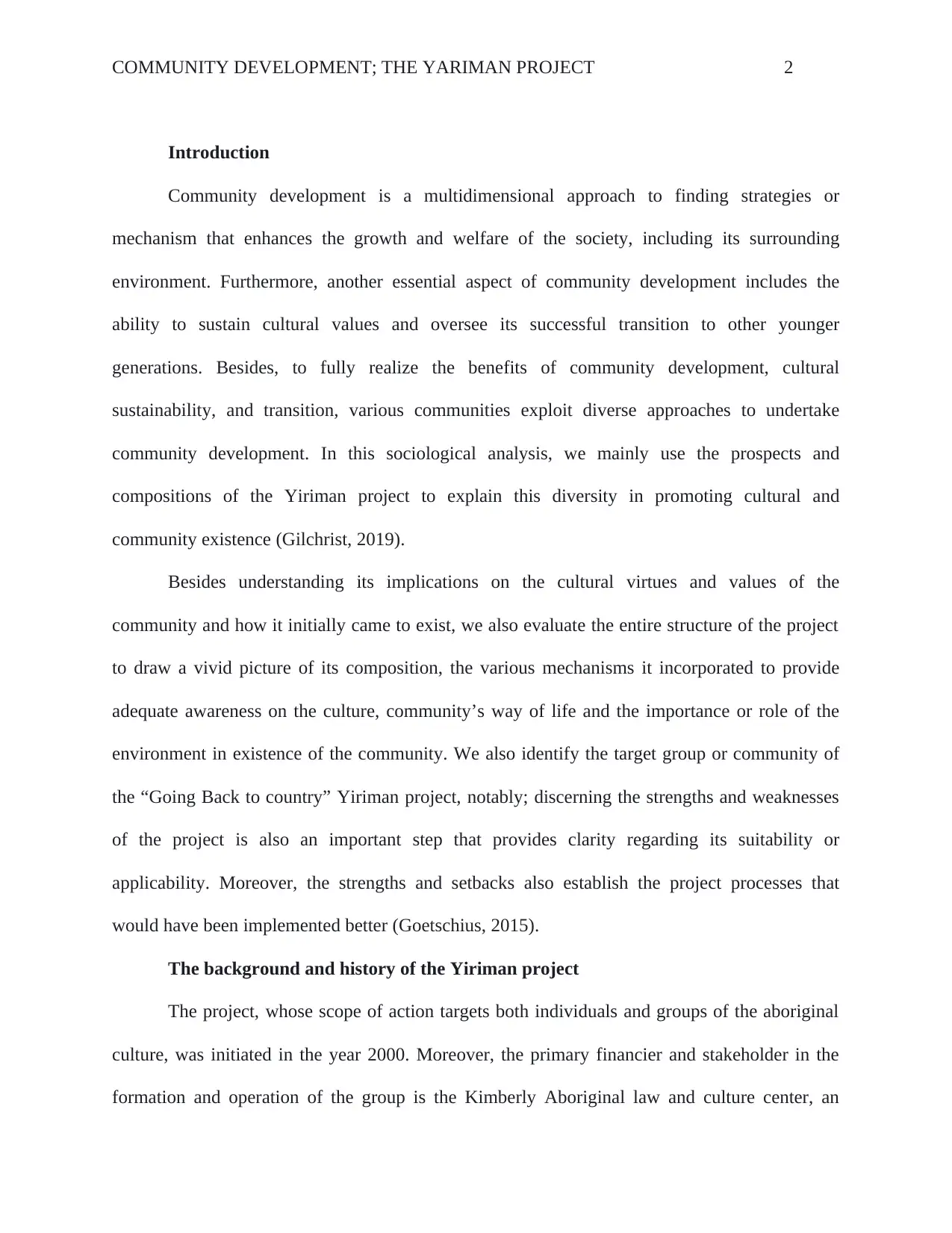
COMMUNITY DEVELOPMENT; THE YARIMAN PROJECT 2
Introduction
Community development is a multidimensional approach to finding strategies or
mechanism that enhances the growth and welfare of the society, including its surrounding
environment. Furthermore, another essential aspect of community development includes the
ability to sustain cultural values and oversee its successful transition to other younger
generations. Besides, to fully realize the benefits of community development, cultural
sustainability, and transition, various communities exploit diverse approaches to undertake
community development. In this sociological analysis, we mainly use the prospects and
compositions of the Yiriman project to explain this diversity in promoting cultural and
community existence (Gilchrist, 2019).
Besides understanding its implications on the cultural virtues and values of the
community and how it initially came to exist, we also evaluate the entire structure of the project
to draw a vivid picture of its composition, the various mechanisms it incorporated to provide
adequate awareness on the culture, community’s way of life and the importance or role of the
environment in existence of the community. We also identify the target group or community of
the “Going Back to country” Yiriman project, notably; discerning the strengths and weaknesses
of the project is also an important step that provides clarity regarding its suitability or
applicability. Moreover, the strengths and setbacks also establish the project processes that
would have been implemented better (Goetschius, 2015).
The background and history of the Yiriman project
The project, whose scope of action targets both individuals and groups of the aboriginal
culture, was initiated in the year 2000. Moreover, the primary financier and stakeholder in the
formation and operation of the group is the Kimberly Aboriginal law and culture center, an
Introduction
Community development is a multidimensional approach to finding strategies or
mechanism that enhances the growth and welfare of the society, including its surrounding
environment. Furthermore, another essential aspect of community development includes the
ability to sustain cultural values and oversee its successful transition to other younger
generations. Besides, to fully realize the benefits of community development, cultural
sustainability, and transition, various communities exploit diverse approaches to undertake
community development. In this sociological analysis, we mainly use the prospects and
compositions of the Yiriman project to explain this diversity in promoting cultural and
community existence (Gilchrist, 2019).
Besides understanding its implications on the cultural virtues and values of the
community and how it initially came to exist, we also evaluate the entire structure of the project
to draw a vivid picture of its composition, the various mechanisms it incorporated to provide
adequate awareness on the culture, community’s way of life and the importance or role of the
environment in existence of the community. We also identify the target group or community of
the “Going Back to country” Yiriman project, notably; discerning the strengths and weaknesses
of the project is also an important step that provides clarity regarding its suitability or
applicability. Moreover, the strengths and setbacks also establish the project processes that
would have been implemented better (Goetschius, 2015).
The background and history of the Yiriman project
The project, whose scope of action targets both individuals and groups of the aboriginal
culture, was initiated in the year 2000. Moreover, the primary financier and stakeholder in the
formation and operation of the group is the Kimberly Aboriginal law and culture center, an
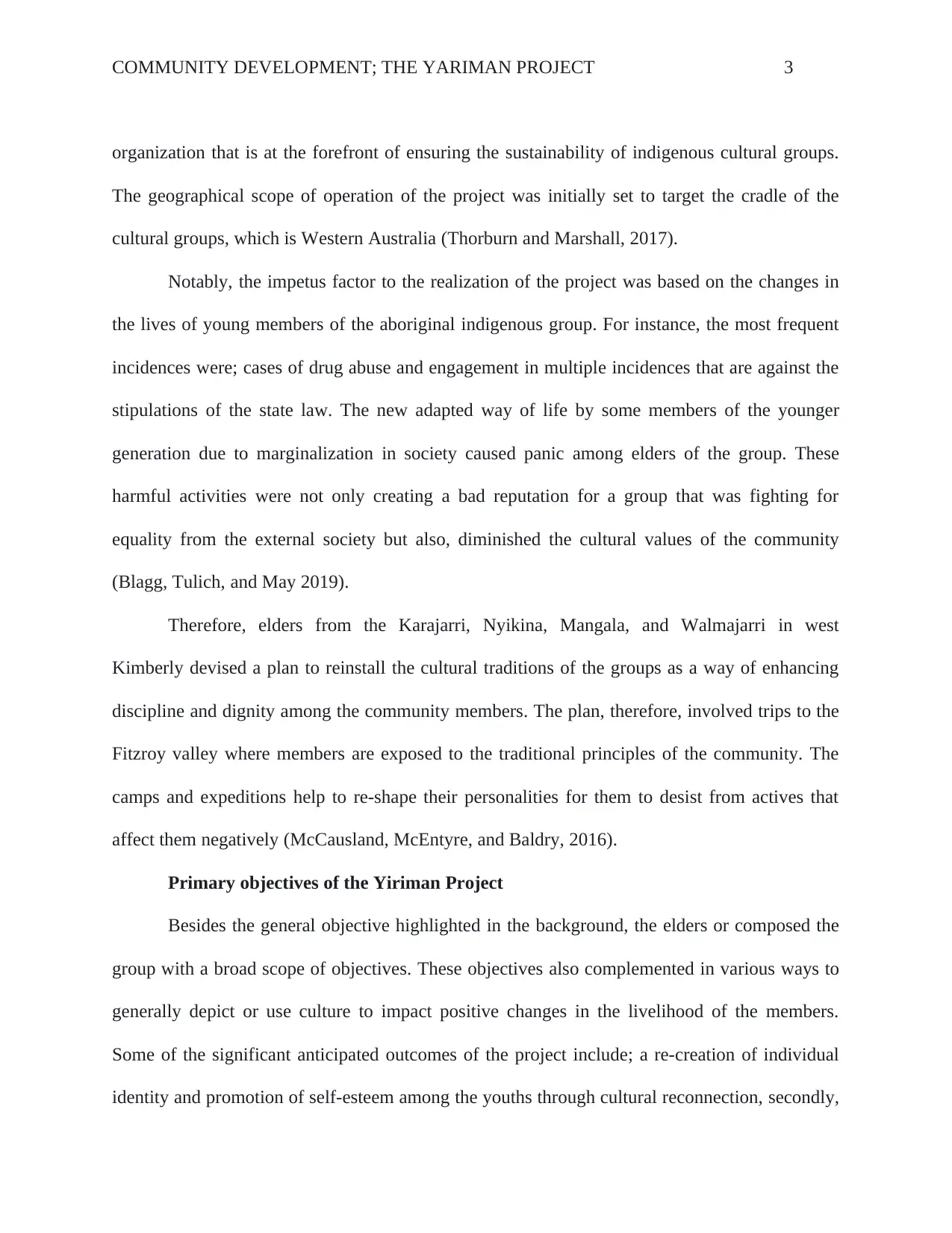
COMMUNITY DEVELOPMENT; THE YARIMAN PROJECT 3
organization that is at the forefront of ensuring the sustainability of indigenous cultural groups.
The geographical scope of operation of the project was initially set to target the cradle of the
cultural groups, which is Western Australia (Thorburn and Marshall, 2017).
Notably, the impetus factor to the realization of the project was based on the changes in
the lives of young members of the aboriginal indigenous group. For instance, the most frequent
incidences were; cases of drug abuse and engagement in multiple incidences that are against the
stipulations of the state law. The new adapted way of life by some members of the younger
generation due to marginalization in society caused panic among elders of the group. These
harmful activities were not only creating a bad reputation for a group that was fighting for
equality from the external society but also, diminished the cultural values of the community
(Blagg, Tulich, and May 2019).
Therefore, elders from the Karajarri, Nyikina, Mangala, and Walmajarri in west
Kimberly devised a plan to reinstall the cultural traditions of the groups as a way of enhancing
discipline and dignity among the community members. The plan, therefore, involved trips to the
Fitzroy valley where members are exposed to the traditional principles of the community. The
camps and expeditions help to re-shape their personalities for them to desist from actives that
affect them negatively (McCausland, McEntyre, and Baldry, 2016).
Primary objectives of the Yiriman Project
Besides the general objective highlighted in the background, the elders or composed the
group with a broad scope of objectives. These objectives also complemented in various ways to
generally depict or use culture to impact positive changes in the livelihood of the members.
Some of the significant anticipated outcomes of the project include; a re-creation of individual
identity and promotion of self-esteem among the youths through cultural reconnection, secondly,
organization that is at the forefront of ensuring the sustainability of indigenous cultural groups.
The geographical scope of operation of the project was initially set to target the cradle of the
cultural groups, which is Western Australia (Thorburn and Marshall, 2017).
Notably, the impetus factor to the realization of the project was based on the changes in
the lives of young members of the aboriginal indigenous group. For instance, the most frequent
incidences were; cases of drug abuse and engagement in multiple incidences that are against the
stipulations of the state law. The new adapted way of life by some members of the younger
generation due to marginalization in society caused panic among elders of the group. These
harmful activities were not only creating a bad reputation for a group that was fighting for
equality from the external society but also, diminished the cultural values of the community
(Blagg, Tulich, and May 2019).
Therefore, elders from the Karajarri, Nyikina, Mangala, and Walmajarri in west
Kimberly devised a plan to reinstall the cultural traditions of the groups as a way of enhancing
discipline and dignity among the community members. The plan, therefore, involved trips to the
Fitzroy valley where members are exposed to the traditional principles of the community. The
camps and expeditions help to re-shape their personalities for them to desist from actives that
affect them negatively (McCausland, McEntyre, and Baldry, 2016).
Primary objectives of the Yiriman Project
Besides the general objective highlighted in the background, the elders or composed the
group with a broad scope of objectives. These objectives also complemented in various ways to
generally depict or use culture to impact positive changes in the livelihood of the members.
Some of the significant anticipated outcomes of the project include; a re-creation of individual
identity and promotion of self-esteem among the youths through cultural reconnection, secondly,
⊘ This is a preview!⊘
Do you want full access?
Subscribe today to unlock all pages.

Trusted by 1+ million students worldwide
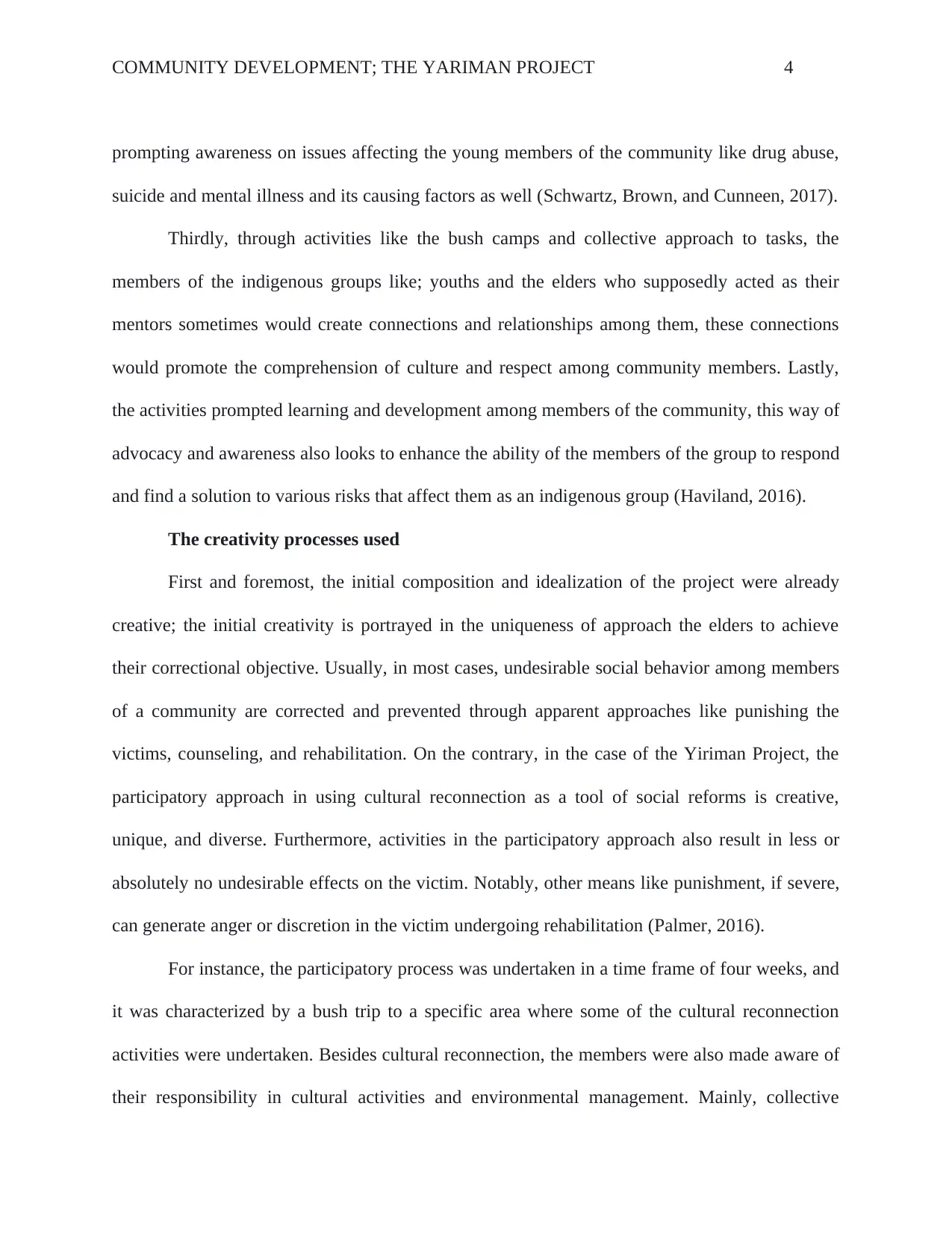
COMMUNITY DEVELOPMENT; THE YARIMAN PROJECT 4
prompting awareness on issues affecting the young members of the community like drug abuse,
suicide and mental illness and its causing factors as well (Schwartz, Brown, and Cunneen, 2017).
Thirdly, through activities like the bush camps and collective approach to tasks, the
members of the indigenous groups like; youths and the elders who supposedly acted as their
mentors sometimes would create connections and relationships among them, these connections
would promote the comprehension of culture and respect among community members. Lastly,
the activities prompted learning and development among members of the community, this way of
advocacy and awareness also looks to enhance the ability of the members of the group to respond
and find a solution to various risks that affect them as an indigenous group (Haviland, 2016).
The creativity processes used
First and foremost, the initial composition and idealization of the project were already
creative; the initial creativity is portrayed in the uniqueness of approach the elders to achieve
their correctional objective. Usually, in most cases, undesirable social behavior among members
of a community are corrected and prevented through apparent approaches like punishing the
victims, counseling, and rehabilitation. On the contrary, in the case of the Yiriman Project, the
participatory approach in using cultural reconnection as a tool of social reforms is creative,
unique, and diverse. Furthermore, activities in the participatory approach also result in less or
absolutely no undesirable effects on the victim. Notably, other means like punishment, if severe,
can generate anger or discretion in the victim undergoing rehabilitation (Palmer, 2016).
For instance, the participatory process was undertaken in a time frame of four weeks, and
it was characterized by a bush trip to a specific area where some of the cultural reconnection
activities were undertaken. Besides cultural reconnection, the members were also made aware of
their responsibility in cultural activities and environmental management. Mainly, collective
prompting awareness on issues affecting the young members of the community like drug abuse,
suicide and mental illness and its causing factors as well (Schwartz, Brown, and Cunneen, 2017).
Thirdly, through activities like the bush camps and collective approach to tasks, the
members of the indigenous groups like; youths and the elders who supposedly acted as their
mentors sometimes would create connections and relationships among them, these connections
would promote the comprehension of culture and respect among community members. Lastly,
the activities prompted learning and development among members of the community, this way of
advocacy and awareness also looks to enhance the ability of the members of the group to respond
and find a solution to various risks that affect them as an indigenous group (Haviland, 2016).
The creativity processes used
First and foremost, the initial composition and idealization of the project were already
creative; the initial creativity is portrayed in the uniqueness of approach the elders to achieve
their correctional objective. Usually, in most cases, undesirable social behavior among members
of a community are corrected and prevented through apparent approaches like punishing the
victims, counseling, and rehabilitation. On the contrary, in the case of the Yiriman Project, the
participatory approach in using cultural reconnection as a tool of social reforms is creative,
unique, and diverse. Furthermore, activities in the participatory approach also result in less or
absolutely no undesirable effects on the victim. Notably, other means like punishment, if severe,
can generate anger or discretion in the victim undergoing rehabilitation (Palmer, 2016).
For instance, the participatory process was undertaken in a time frame of four weeks, and
it was characterized by a bush trip to a specific area where some of the cultural reconnection
activities were undertaken. Besides cultural reconnection, the members were also made aware of
their responsibility in cultural activities and environmental management. Mainly, collective
Paraphrase This Document
Need a fresh take? Get an instant paraphrase of this document with our AI Paraphraser
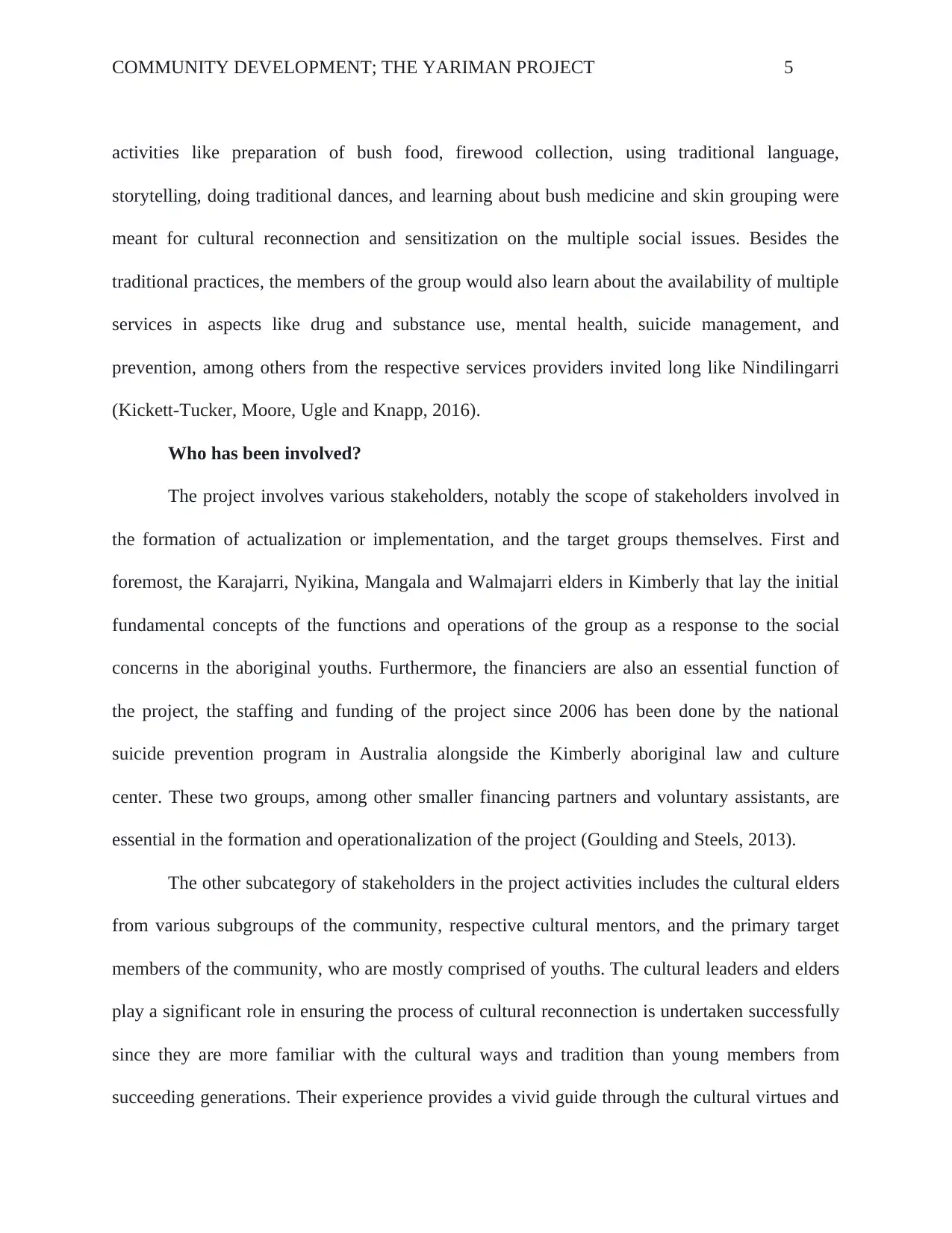
COMMUNITY DEVELOPMENT; THE YARIMAN PROJECT 5
activities like preparation of bush food, firewood collection, using traditional language,
storytelling, doing traditional dances, and learning about bush medicine and skin grouping were
meant for cultural reconnection and sensitization on the multiple social issues. Besides the
traditional practices, the members of the group would also learn about the availability of multiple
services in aspects like drug and substance use, mental health, suicide management, and
prevention, among others from the respective services providers invited long like Nindilingarri
(Kickett-Tucker, Moore, Ugle and Knapp, 2016).
Who has been involved?
The project involves various stakeholders, notably the scope of stakeholders involved in
the formation of actualization or implementation, and the target groups themselves. First and
foremost, the Karajarri, Nyikina, Mangala and Walmajarri elders in Kimberly that lay the initial
fundamental concepts of the functions and operations of the group as a response to the social
concerns in the aboriginal youths. Furthermore, the financiers are also an essential function of
the project, the staffing and funding of the project since 2006 has been done by the national
suicide prevention program in Australia alongside the Kimberly aboriginal law and culture
center. These two groups, among other smaller financing partners and voluntary assistants, are
essential in the formation and operationalization of the project (Goulding and Steels, 2013).
The other subcategory of stakeholders in the project activities includes the cultural elders
from various subgroups of the community, respective cultural mentors, and the primary target
members of the community, who are mostly comprised of youths. The cultural leaders and elders
play a significant role in ensuring the process of cultural reconnection is undertaken successfully
since they are more familiar with the cultural ways and tradition than young members from
succeeding generations. Their experience provides a vivid guide through the cultural virtues and
activities like preparation of bush food, firewood collection, using traditional language,
storytelling, doing traditional dances, and learning about bush medicine and skin grouping were
meant for cultural reconnection and sensitization on the multiple social issues. Besides the
traditional practices, the members of the group would also learn about the availability of multiple
services in aspects like drug and substance use, mental health, suicide management, and
prevention, among others from the respective services providers invited long like Nindilingarri
(Kickett-Tucker, Moore, Ugle and Knapp, 2016).
Who has been involved?
The project involves various stakeholders, notably the scope of stakeholders involved in
the formation of actualization or implementation, and the target groups themselves. First and
foremost, the Karajarri, Nyikina, Mangala and Walmajarri elders in Kimberly that lay the initial
fundamental concepts of the functions and operations of the group as a response to the social
concerns in the aboriginal youths. Furthermore, the financiers are also an essential function of
the project, the staffing and funding of the project since 2006 has been done by the national
suicide prevention program in Australia alongside the Kimberly aboriginal law and culture
center. These two groups, among other smaller financing partners and voluntary assistants, are
essential in the formation and operationalization of the project (Goulding and Steels, 2013).
The other subcategory of stakeholders in the project activities includes the cultural elders
from various subgroups of the community, respective cultural mentors, and the primary target
members of the community, who are mostly comprised of youths. The cultural leaders and elders
play a significant role in ensuring the process of cultural reconnection is undertaken successfully
since they are more familiar with the cultural ways and tradition than young members from
succeeding generations. Their experience provides a vivid guide through the cultural virtues and
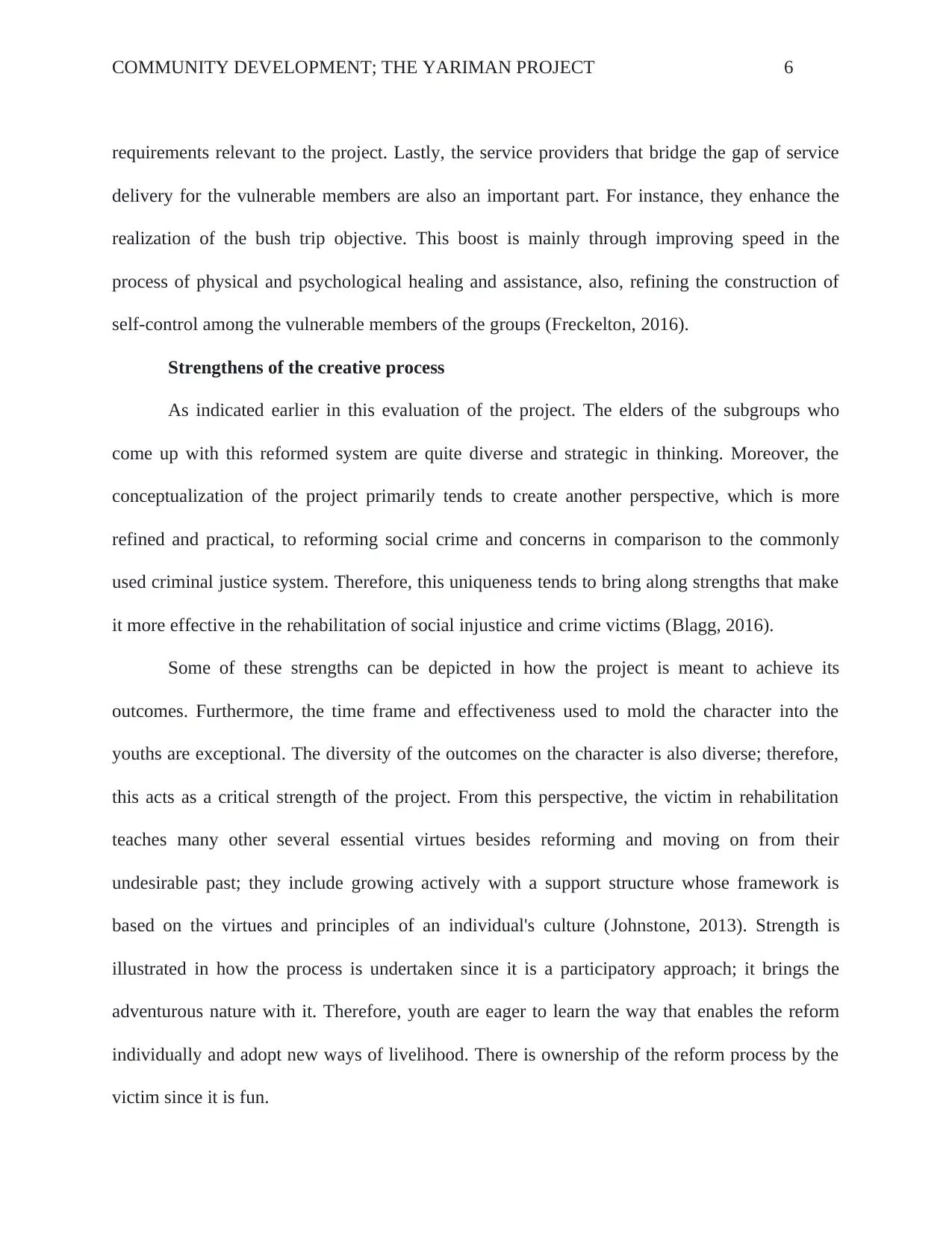
COMMUNITY DEVELOPMENT; THE YARIMAN PROJECT 6
requirements relevant to the project. Lastly, the service providers that bridge the gap of service
delivery for the vulnerable members are also an important part. For instance, they enhance the
realization of the bush trip objective. This boost is mainly through improving speed in the
process of physical and psychological healing and assistance, also, refining the construction of
self-control among the vulnerable members of the groups (Freckelton, 2016).
Strengthens of the creative process
As indicated earlier in this evaluation of the project. The elders of the subgroups who
come up with this reformed system are quite diverse and strategic in thinking. Moreover, the
conceptualization of the project primarily tends to create another perspective, which is more
refined and practical, to reforming social crime and concerns in comparison to the commonly
used criminal justice system. Therefore, this uniqueness tends to bring along strengths that make
it more effective in the rehabilitation of social injustice and crime victims (Blagg, 2016).
Some of these strengths can be depicted in how the project is meant to achieve its
outcomes. Furthermore, the time frame and effectiveness used to mold the character into the
youths are exceptional. The diversity of the outcomes on the character is also diverse; therefore,
this acts as a critical strength of the project. From this perspective, the victim in rehabilitation
teaches many other several essential virtues besides reforming and moving on from their
undesirable past; they include growing actively with a support structure whose framework is
based on the virtues and principles of an individual's culture (Johnstone, 2013). Strength is
illustrated in how the process is undertaken since it is a participatory approach; it brings the
adventurous nature with it. Therefore, youth are eager to learn the way that enables the reform
individually and adopt new ways of livelihood. There is ownership of the reform process by the
victim since it is fun.
requirements relevant to the project. Lastly, the service providers that bridge the gap of service
delivery for the vulnerable members are also an important part. For instance, they enhance the
realization of the bush trip objective. This boost is mainly through improving speed in the
process of physical and psychological healing and assistance, also, refining the construction of
self-control among the vulnerable members of the groups (Freckelton, 2016).
Strengthens of the creative process
As indicated earlier in this evaluation of the project. The elders of the subgroups who
come up with this reformed system are quite diverse and strategic in thinking. Moreover, the
conceptualization of the project primarily tends to create another perspective, which is more
refined and practical, to reforming social crime and concerns in comparison to the commonly
used criminal justice system. Therefore, this uniqueness tends to bring along strengths that make
it more effective in the rehabilitation of social injustice and crime victims (Blagg, 2016).
Some of these strengths can be depicted in how the project is meant to achieve its
outcomes. Furthermore, the time frame and effectiveness used to mold the character into the
youths are exceptional. The diversity of the outcomes on the character is also diverse; therefore,
this acts as a critical strength of the project. From this perspective, the victim in rehabilitation
teaches many other several essential virtues besides reforming and moving on from their
undesirable past; they include growing actively with a support structure whose framework is
based on the virtues and principles of an individual's culture (Johnstone, 2013). Strength is
illustrated in how the process is undertaken since it is a participatory approach; it brings the
adventurous nature with it. Therefore, youth are eager to learn the way that enables the reform
individually and adopt new ways of livelihood. There is ownership of the reform process by the
victim since it is fun.
⊘ This is a preview!⊘
Do you want full access?
Subscribe today to unlock all pages.

Trusted by 1+ million students worldwide
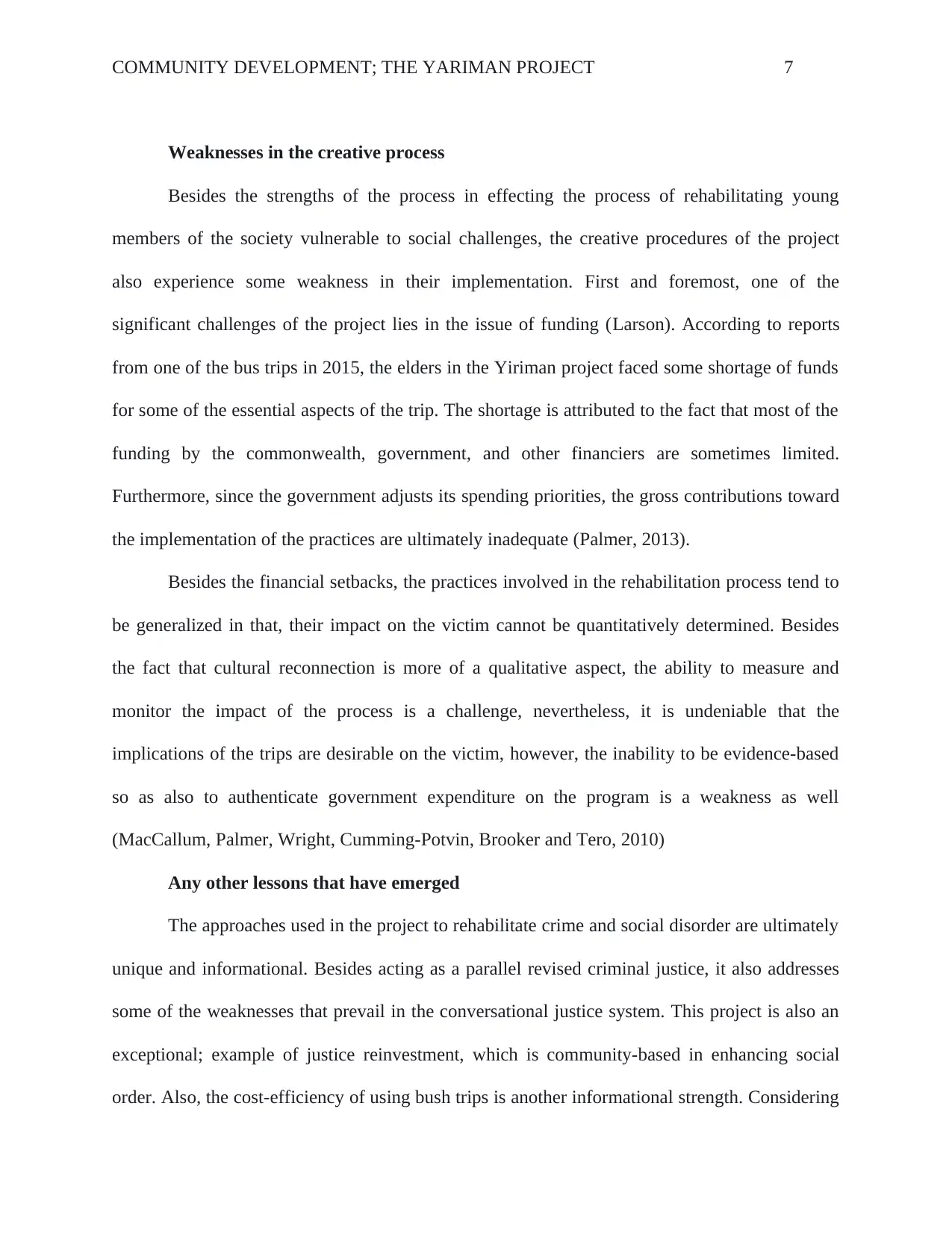
COMMUNITY DEVELOPMENT; THE YARIMAN PROJECT 7
Weaknesses in the creative process
Besides the strengths of the process in effecting the process of rehabilitating young
members of the society vulnerable to social challenges, the creative procedures of the project
also experience some weakness in their implementation. First and foremost, one of the
significant challenges of the project lies in the issue of funding (Larson). According to reports
from one of the bus trips in 2015, the elders in the Yiriman project faced some shortage of funds
for some of the essential aspects of the trip. The shortage is attributed to the fact that most of the
funding by the commonwealth, government, and other financiers are sometimes limited.
Furthermore, since the government adjusts its spending priorities, the gross contributions toward
the implementation of the practices are ultimately inadequate (Palmer, 2013).
Besides the financial setbacks, the practices involved in the rehabilitation process tend to
be generalized in that, their impact on the victim cannot be quantitatively determined. Besides
the fact that cultural reconnection is more of a qualitative aspect, the ability to measure and
monitor the impact of the process is a challenge, nevertheless, it is undeniable that the
implications of the trips are desirable on the victim, however, the inability to be evidence-based
so as also to authenticate government expenditure on the program is a weakness as well
(MacCallum, Palmer, Wright, Cumming-Potvin, Brooker and Tero, 2010)
Any other lessons that have emerged
The approaches used in the project to rehabilitate crime and social disorder are ultimately
unique and informational. Besides acting as a parallel revised criminal justice, it also addresses
some of the weaknesses that prevail in the conversational justice system. This project is also an
exceptional; example of justice reinvestment, which is community-based in enhancing social
order. Also, the cost-efficiency of using bush trips is another informational strength. Considering
Weaknesses in the creative process
Besides the strengths of the process in effecting the process of rehabilitating young
members of the society vulnerable to social challenges, the creative procedures of the project
also experience some weakness in their implementation. First and foremost, one of the
significant challenges of the project lies in the issue of funding (Larson). According to reports
from one of the bus trips in 2015, the elders in the Yiriman project faced some shortage of funds
for some of the essential aspects of the trip. The shortage is attributed to the fact that most of the
funding by the commonwealth, government, and other financiers are sometimes limited.
Furthermore, since the government adjusts its spending priorities, the gross contributions toward
the implementation of the practices are ultimately inadequate (Palmer, 2013).
Besides the financial setbacks, the practices involved in the rehabilitation process tend to
be generalized in that, their impact on the victim cannot be quantitatively determined. Besides
the fact that cultural reconnection is more of a qualitative aspect, the ability to measure and
monitor the impact of the process is a challenge, nevertheless, it is undeniable that the
implications of the trips are desirable on the victim, however, the inability to be evidence-based
so as also to authenticate government expenditure on the program is a weakness as well
(MacCallum, Palmer, Wright, Cumming-Potvin, Brooker and Tero, 2010)
Any other lessons that have emerged
The approaches used in the project to rehabilitate crime and social disorder are ultimately
unique and informational. Besides acting as a parallel revised criminal justice, it also addresses
some of the weaknesses that prevail in the conversational justice system. This project is also an
exceptional; example of justice reinvestment, which is community-based in enhancing social
order. Also, the cost-efficiency of using bush trips is another informational strength. Considering
Paraphrase This Document
Need a fresh take? Get an instant paraphrase of this document with our AI Paraphraser
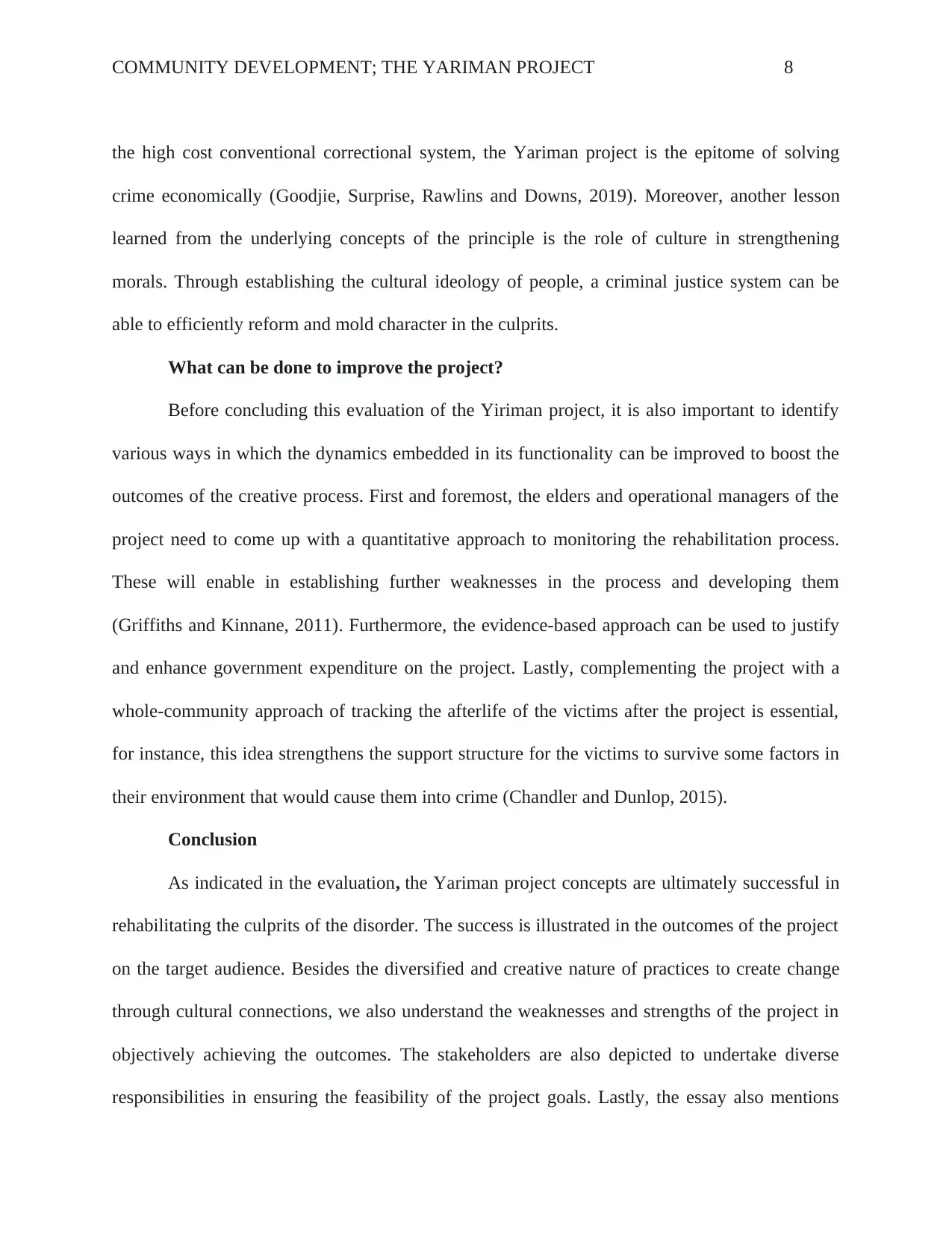
COMMUNITY DEVELOPMENT; THE YARIMAN PROJECT 8
the high cost conventional correctional system, the Yariman project is the epitome of solving
crime economically (Goodjie, Surprise, Rawlins and Downs, 2019). Moreover, another lesson
learned from the underlying concepts of the principle is the role of culture in strengthening
morals. Through establishing the cultural ideology of people, a criminal justice system can be
able to efficiently reform and mold character in the culprits.
What can be done to improve the project?
Before concluding this evaluation of the Yiriman project, it is also important to identify
various ways in which the dynamics embedded in its functionality can be improved to boost the
outcomes of the creative process. First and foremost, the elders and operational managers of the
project need to come up with a quantitative approach to monitoring the rehabilitation process.
These will enable in establishing further weaknesses in the process and developing them
(Griffiths and Kinnane, 2011). Furthermore, the evidence-based approach can be used to justify
and enhance government expenditure on the project. Lastly, complementing the project with a
whole-community approach of tracking the afterlife of the victims after the project is essential,
for instance, this idea strengthens the support structure for the victims to survive some factors in
their environment that would cause them into crime (Chandler and Dunlop, 2015).
Conclusion
As indicated in the evaluation, the Yariman project concepts are ultimately successful in
rehabilitating the culprits of the disorder. The success is illustrated in the outcomes of the project
on the target audience. Besides the diversified and creative nature of practices to create change
through cultural connections, we also understand the weaknesses and strengths of the project in
objectively achieving the outcomes. The stakeholders are also depicted to undertake diverse
responsibilities in ensuring the feasibility of the project goals. Lastly, the essay also mentions
the high cost conventional correctional system, the Yariman project is the epitome of solving
crime economically (Goodjie, Surprise, Rawlins and Downs, 2019). Moreover, another lesson
learned from the underlying concepts of the principle is the role of culture in strengthening
morals. Through establishing the cultural ideology of people, a criminal justice system can be
able to efficiently reform and mold character in the culprits.
What can be done to improve the project?
Before concluding this evaluation of the Yiriman project, it is also important to identify
various ways in which the dynamics embedded in its functionality can be improved to boost the
outcomes of the creative process. First and foremost, the elders and operational managers of the
project need to come up with a quantitative approach to monitoring the rehabilitation process.
These will enable in establishing further weaknesses in the process and developing them
(Griffiths and Kinnane, 2011). Furthermore, the evidence-based approach can be used to justify
and enhance government expenditure on the project. Lastly, complementing the project with a
whole-community approach of tracking the afterlife of the victims after the project is essential,
for instance, this idea strengthens the support structure for the victims to survive some factors in
their environment that would cause them into crime (Chandler and Dunlop, 2015).
Conclusion
As indicated in the evaluation, the Yariman project concepts are ultimately successful in
rehabilitating the culprits of the disorder. The success is illustrated in the outcomes of the project
on the target audience. Besides the diversified and creative nature of practices to create change
through cultural connections, we also understand the weaknesses and strengths of the project in
objectively achieving the outcomes. The stakeholders are also depicted to undertake diverse
responsibilities in ensuring the feasibility of the project goals. Lastly, the essay also mentions
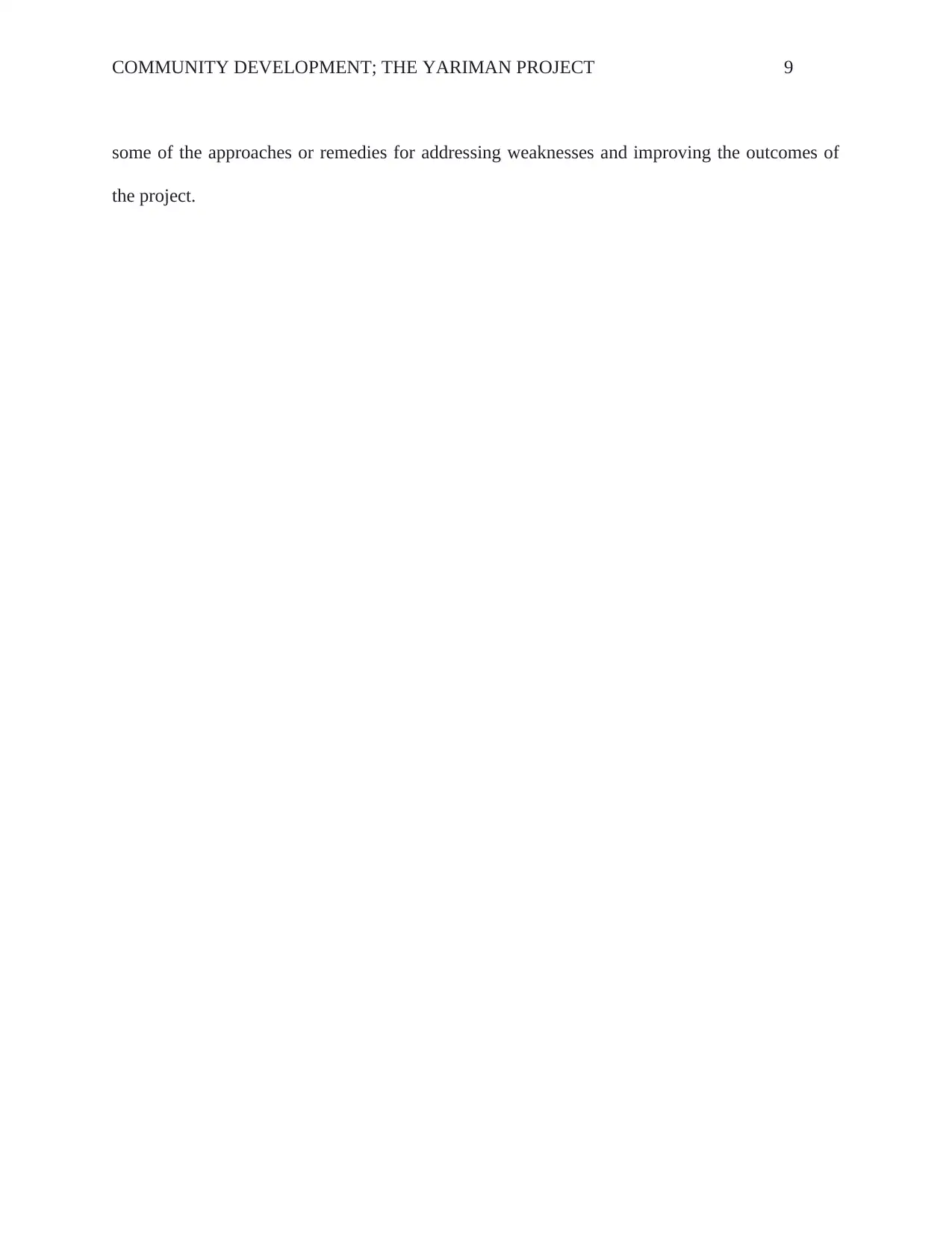
COMMUNITY DEVELOPMENT; THE YARIMAN PROJECT 9
some of the approaches or remedies for addressing weaknesses and improving the outcomes of
the project.
some of the approaches or remedies for addressing weaknesses and improving the outcomes of
the project.
⊘ This is a preview!⊘
Do you want full access?
Subscribe today to unlock all pages.

Trusted by 1+ million students worldwide
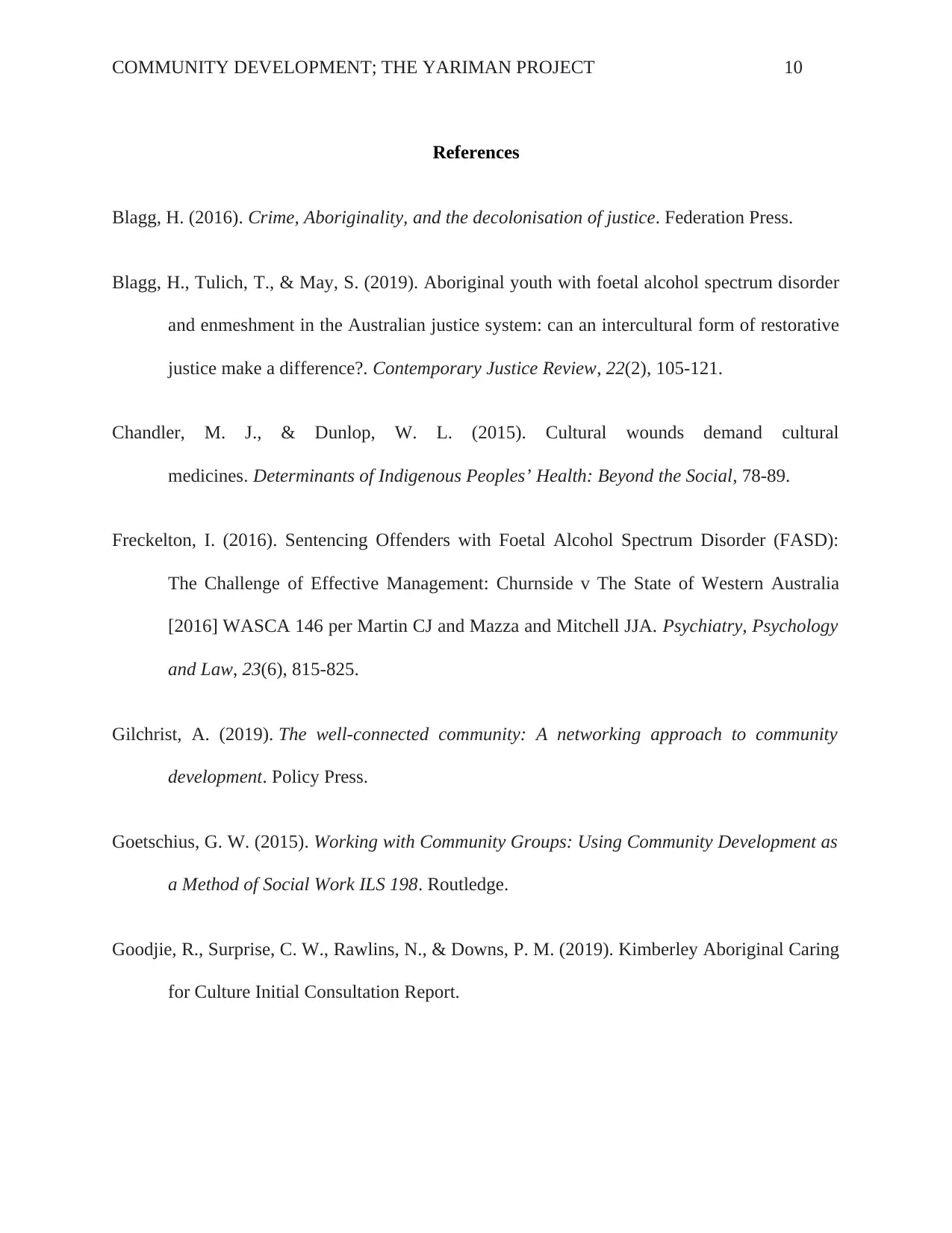
COMMUNITY DEVELOPMENT; THE YARIMAN PROJECT 10
References
Blagg, H. (2016). Crime, Aboriginality, and the decolonisation of justice. Federation Press.
Blagg, H., Tulich, T., & May, S. (2019). Aboriginal youth with foetal alcohol spectrum disorder
and enmeshment in the Australian justice system: can an intercultural form of restorative
justice make a difference?. Contemporary Justice Review, 22(2), 105-121.
Chandler, M. J., & Dunlop, W. L. (2015). Cultural wounds demand cultural
medicines. Determinants of Indigenous Peoples’ Health: Beyond the Social, 78-89.
Freckelton, I. (2016). Sentencing Offenders with Foetal Alcohol Spectrum Disorder (FASD):
The Challenge of Effective Management: Churnside v The State of Western Australia
[2016] WASCA 146 per Martin CJ and Mazza and Mitchell JJA. Psychiatry, Psychology
and Law, 23(6), 815-825.
Gilchrist, A. (2019). The well-connected community: A networking approach to community
development. Policy Press.
Goetschius, G. W. (2015). Working with Community Groups: Using Community Development as
a Method of Social Work ILS 198. Routledge.
Goodjie, R., Surprise, C. W., Rawlins, N., & Downs, P. M. (2019). Kimberley Aboriginal Caring
for Culture Initial Consultation Report.
References
Blagg, H. (2016). Crime, Aboriginality, and the decolonisation of justice. Federation Press.
Blagg, H., Tulich, T., & May, S. (2019). Aboriginal youth with foetal alcohol spectrum disorder
and enmeshment in the Australian justice system: can an intercultural form of restorative
justice make a difference?. Contemporary Justice Review, 22(2), 105-121.
Chandler, M. J., & Dunlop, W. L. (2015). Cultural wounds demand cultural
medicines. Determinants of Indigenous Peoples’ Health: Beyond the Social, 78-89.
Freckelton, I. (2016). Sentencing Offenders with Foetal Alcohol Spectrum Disorder (FASD):
The Challenge of Effective Management: Churnside v The State of Western Australia
[2016] WASCA 146 per Martin CJ and Mazza and Mitchell JJA. Psychiatry, Psychology
and Law, 23(6), 815-825.
Gilchrist, A. (2019). The well-connected community: A networking approach to community
development. Policy Press.
Goetschius, G. W. (2015). Working with Community Groups: Using Community Development as
a Method of Social Work ILS 198. Routledge.
Goodjie, R., Surprise, C. W., Rawlins, N., & Downs, P. M. (2019). Kimberley Aboriginal Caring
for Culture Initial Consultation Report.
Paraphrase This Document
Need a fresh take? Get an instant paraphrase of this document with our AI Paraphraser
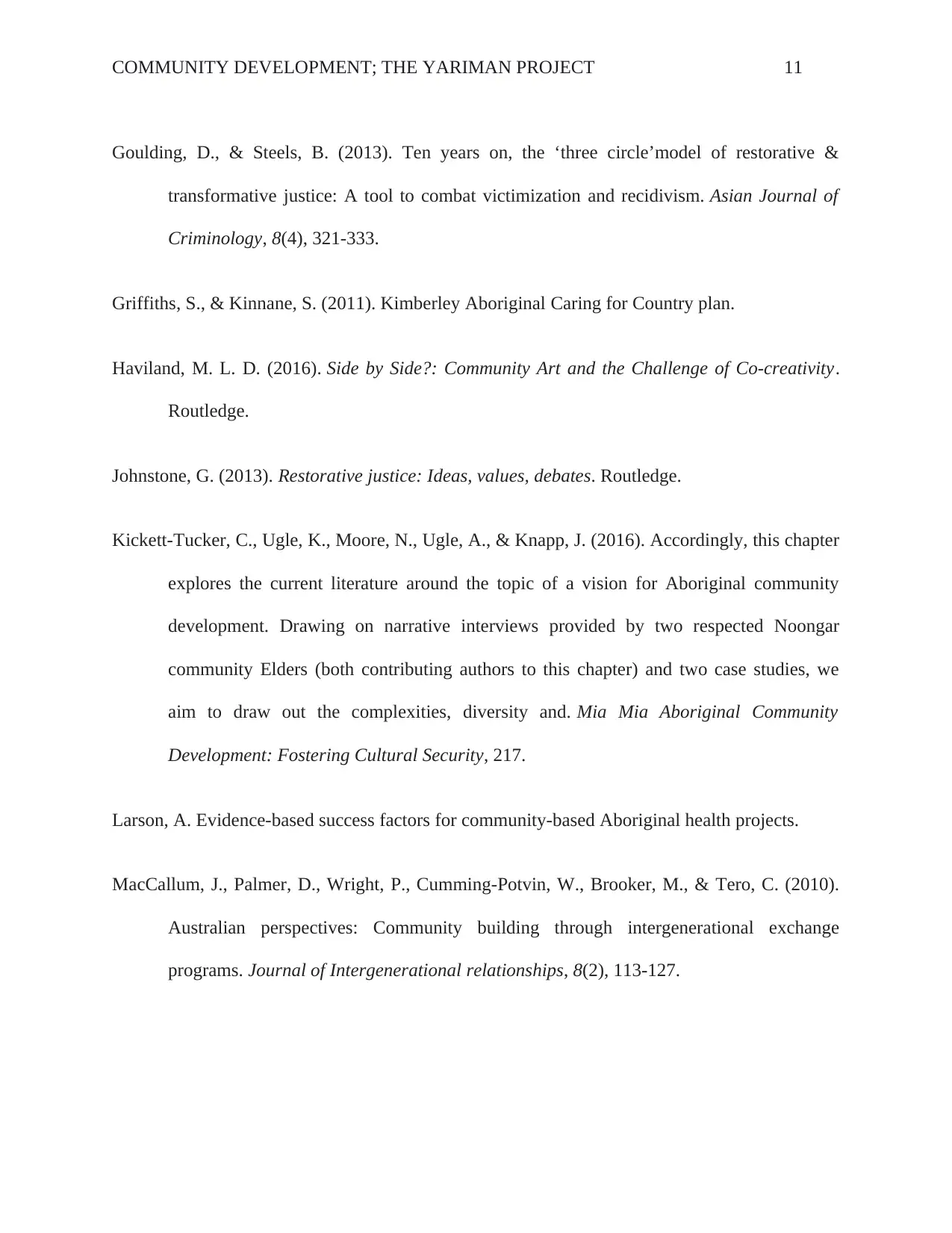
COMMUNITY DEVELOPMENT; THE YARIMAN PROJECT 11
Goulding, D., & Steels, B. (2013). Ten years on, the ‘three circle’model of restorative &
transformative justice: A tool to combat victimization and recidivism. Asian Journal of
Criminology, 8(4), 321-333.
Griffiths, S., & Kinnane, S. (2011). Kimberley Aboriginal Caring for Country plan.
Haviland, M. L. D. (2016). Side by Side?: Community Art and the Challenge of Co-creativity.
Routledge.
Johnstone, G. (2013). Restorative justice: Ideas, values, debates. Routledge.
Kickett-Tucker, C., Ugle, K., Moore, N., Ugle, A., & Knapp, J. (2016). Accordingly, this chapter
explores the current literature around the topic of a vision for Aboriginal community
development. Drawing on narrative interviews provided by two respected Noongar
community Elders (both contributing authors to this chapter) and two case studies, we
aim to draw out the complexities, diversity and. Mia Mia Aboriginal Community
Development: Fostering Cultural Security, 217.
Larson, A. Evidence-based success factors for community-based Aboriginal health projects.
MacCallum, J., Palmer, D., Wright, P., Cumming-Potvin, W., Brooker, M., & Tero, C. (2010).
Australian perspectives: Community building through intergenerational exchange
programs. Journal of Intergenerational relationships, 8(2), 113-127.
Goulding, D., & Steels, B. (2013). Ten years on, the ‘three circle’model of restorative &
transformative justice: A tool to combat victimization and recidivism. Asian Journal of
Criminology, 8(4), 321-333.
Griffiths, S., & Kinnane, S. (2011). Kimberley Aboriginal Caring for Country plan.
Haviland, M. L. D. (2016). Side by Side?: Community Art and the Challenge of Co-creativity.
Routledge.
Johnstone, G. (2013). Restorative justice: Ideas, values, debates. Routledge.
Kickett-Tucker, C., Ugle, K., Moore, N., Ugle, A., & Knapp, J. (2016). Accordingly, this chapter
explores the current literature around the topic of a vision for Aboriginal community
development. Drawing on narrative interviews provided by two respected Noongar
community Elders (both contributing authors to this chapter) and two case studies, we
aim to draw out the complexities, diversity and. Mia Mia Aboriginal Community
Development: Fostering Cultural Security, 217.
Larson, A. Evidence-based success factors for community-based Aboriginal health projects.
MacCallum, J., Palmer, D., Wright, P., Cumming-Potvin, W., Brooker, M., & Tero, C. (2010).
Australian perspectives: Community building through intergenerational exchange
programs. Journal of Intergenerational relationships, 8(2), 113-127.
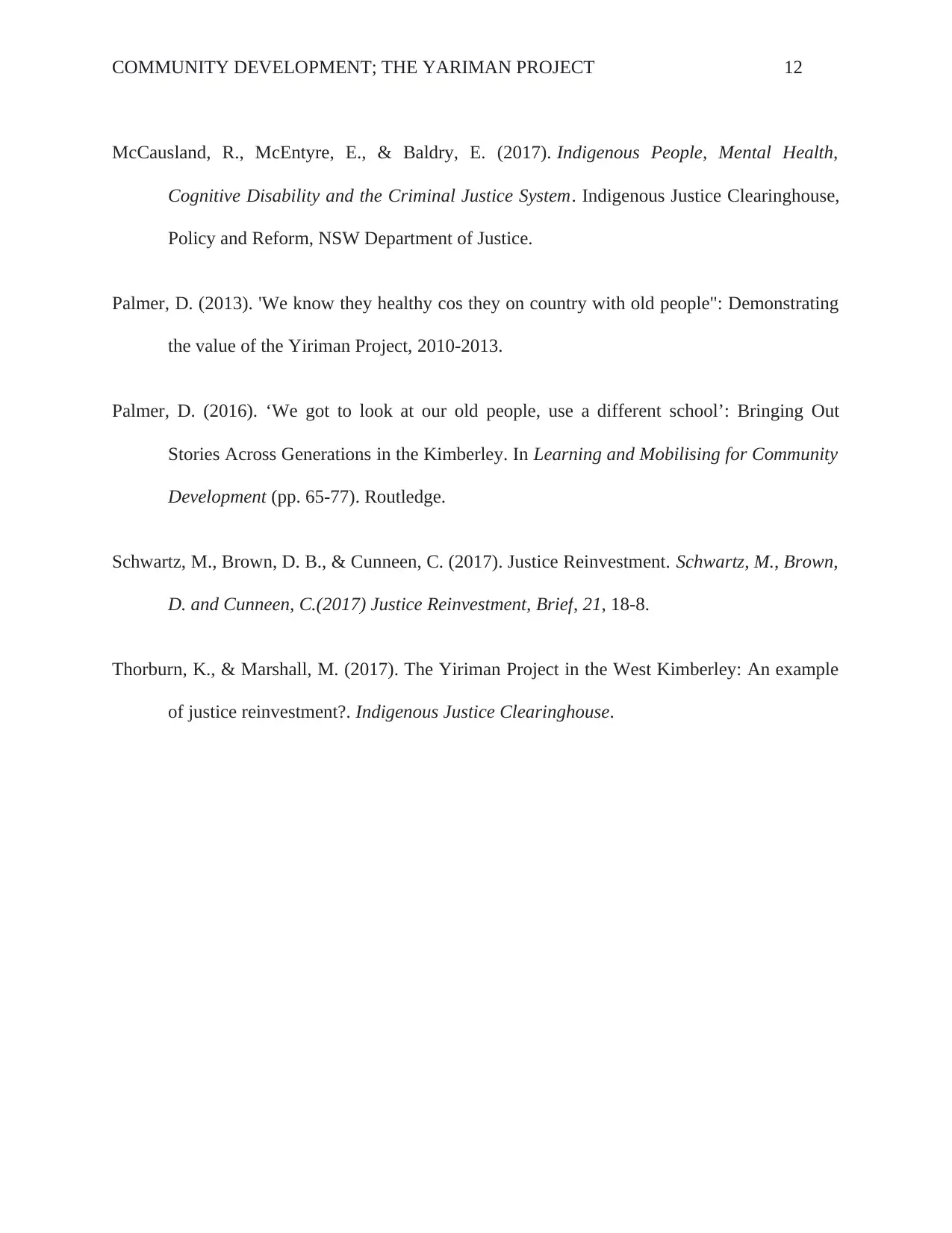
COMMUNITY DEVELOPMENT; THE YARIMAN PROJECT 12
McCausland, R., McEntyre, E., & Baldry, E. (2017). Indigenous People, Mental Health,
Cognitive Disability and the Criminal Justice System. Indigenous Justice Clearinghouse,
Policy and Reform, NSW Department of Justice.
Palmer, D. (2013). 'We know they healthy cos they on country with old people": Demonstrating
the value of the Yiriman Project, 2010-2013.
Palmer, D. (2016). ‘We got to look at our old people, use a different school’: Bringing Out
Stories Across Generations in the Kimberley. In Learning and Mobilising for Community
Development (pp. 65-77). Routledge.
Schwartz, M., Brown, D. B., & Cunneen, C. (2017). Justice Reinvestment. Schwartz, M., Brown,
D. and Cunneen, C.(2017) Justice Reinvestment, Brief, 21, 18-8.
Thorburn, K., & Marshall, M. (2017). The Yiriman Project in the West Kimberley: An example
of justice reinvestment?. Indigenous Justice Clearinghouse.
McCausland, R., McEntyre, E., & Baldry, E. (2017). Indigenous People, Mental Health,
Cognitive Disability and the Criminal Justice System. Indigenous Justice Clearinghouse,
Policy and Reform, NSW Department of Justice.
Palmer, D. (2013). 'We know they healthy cos they on country with old people": Demonstrating
the value of the Yiriman Project, 2010-2013.
Palmer, D. (2016). ‘We got to look at our old people, use a different school’: Bringing Out
Stories Across Generations in the Kimberley. In Learning and Mobilising for Community
Development (pp. 65-77). Routledge.
Schwartz, M., Brown, D. B., & Cunneen, C. (2017). Justice Reinvestment. Schwartz, M., Brown,
D. and Cunneen, C.(2017) Justice Reinvestment, Brief, 21, 18-8.
Thorburn, K., & Marshall, M. (2017). The Yiriman Project in the West Kimberley: An example
of justice reinvestment?. Indigenous Justice Clearinghouse.
⊘ This is a preview!⊘
Do you want full access?
Subscribe today to unlock all pages.

Trusted by 1+ million students worldwide
1 out of 12
Your All-in-One AI-Powered Toolkit for Academic Success.
+13062052269
info@desklib.com
Available 24*7 on WhatsApp / Email
![[object Object]](/_next/static/media/star-bottom.7253800d.svg)
Unlock your academic potential
Copyright © 2020–2025 A2Z Services. All Rights Reserved. Developed and managed by ZUCOL.


